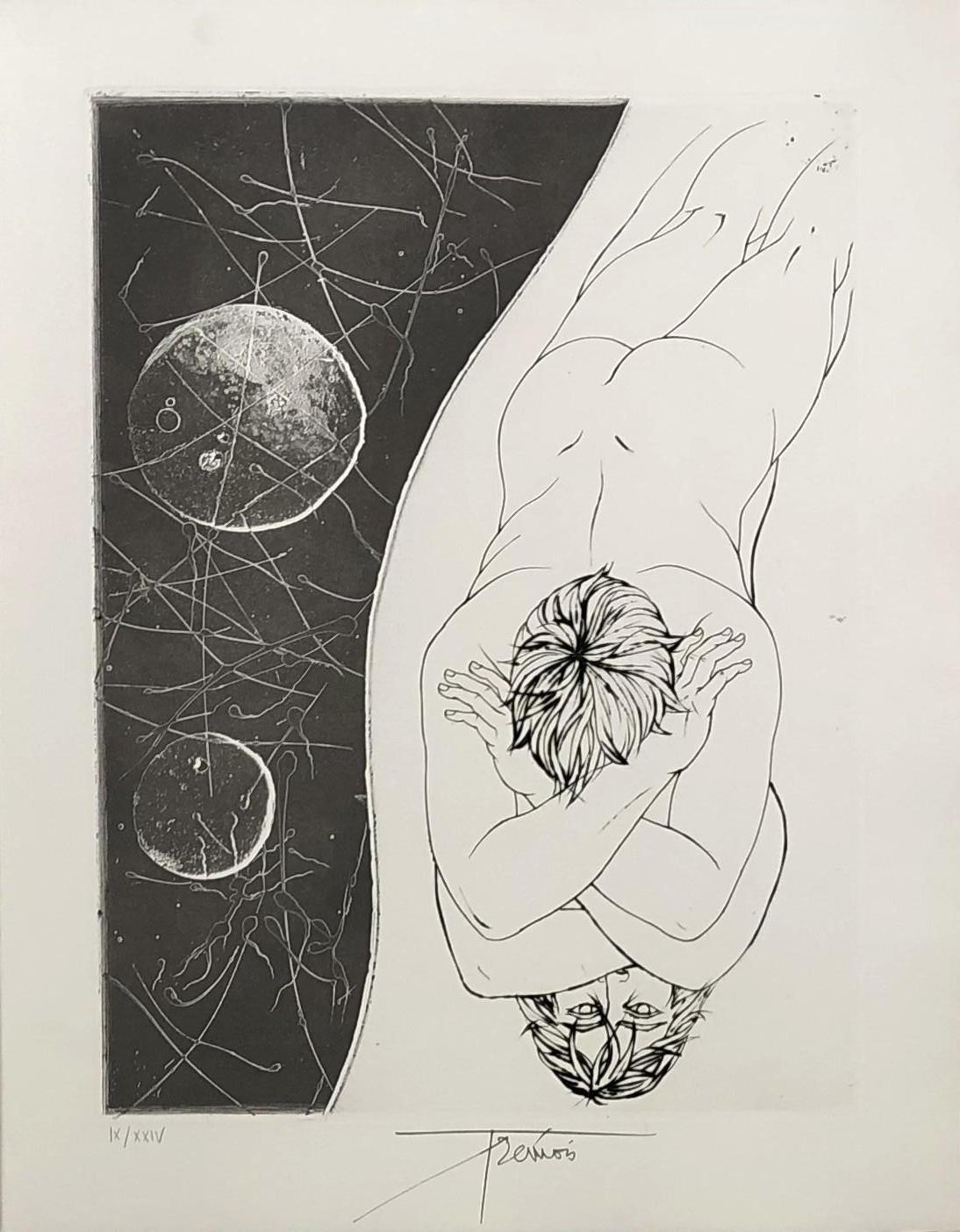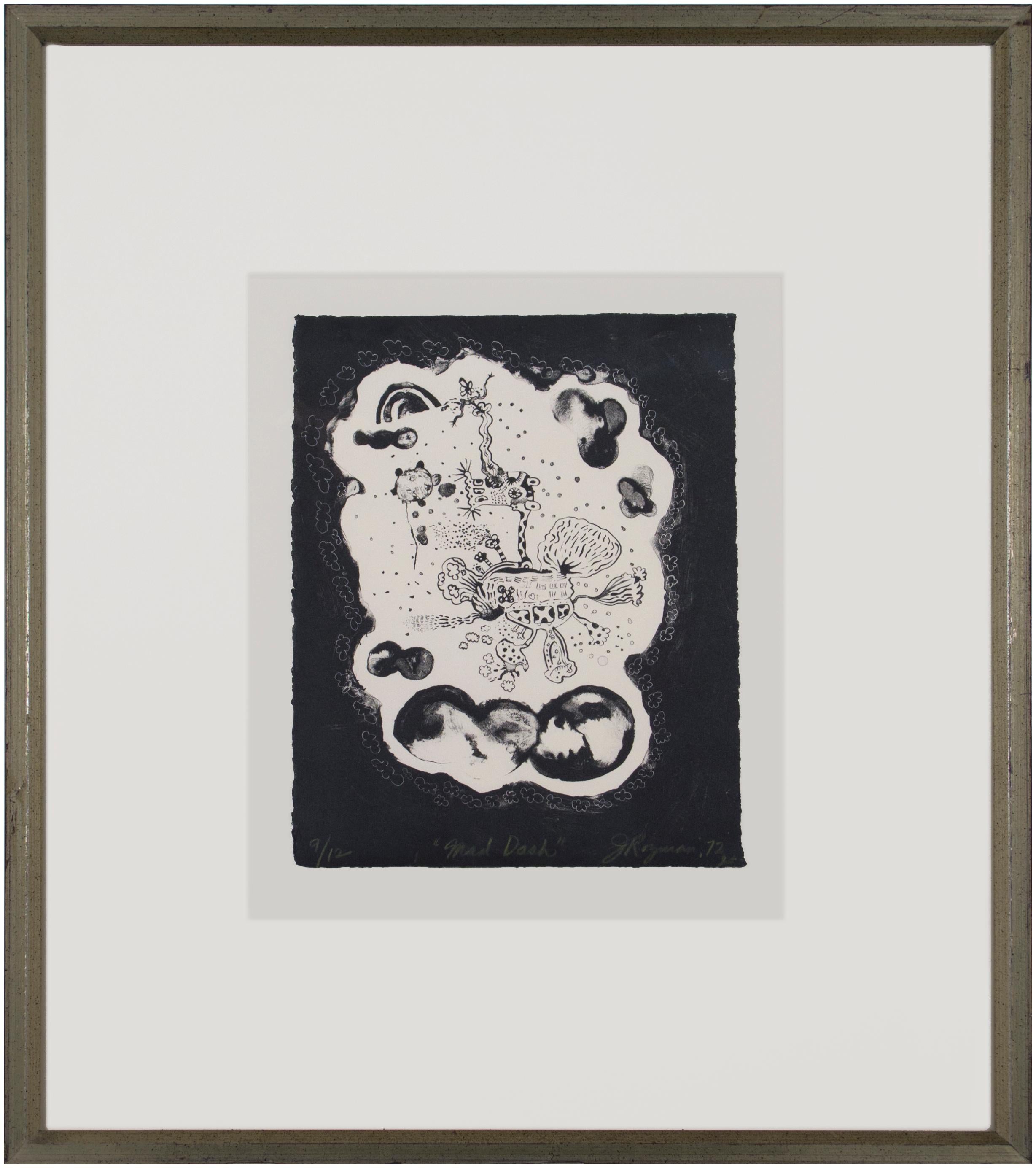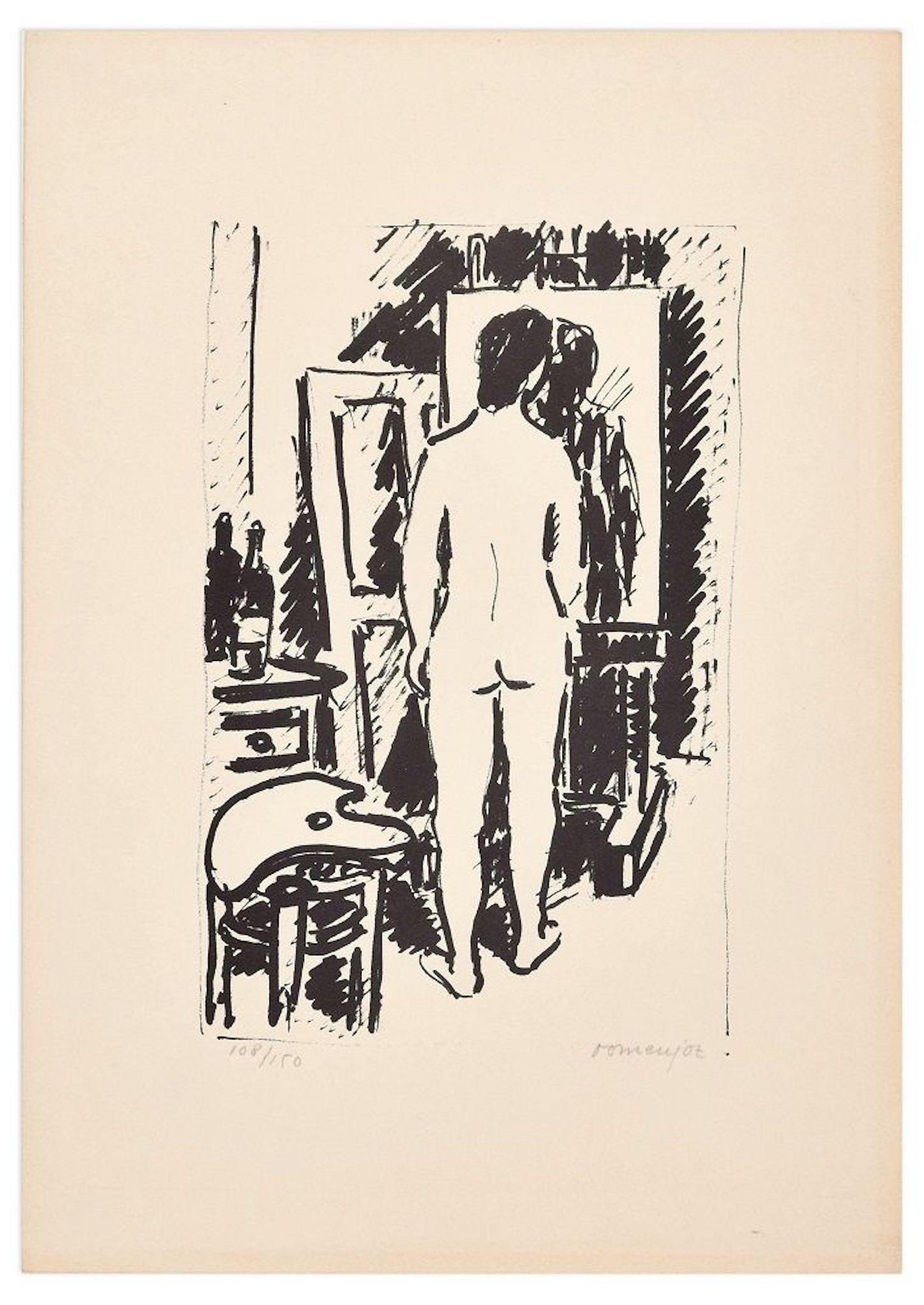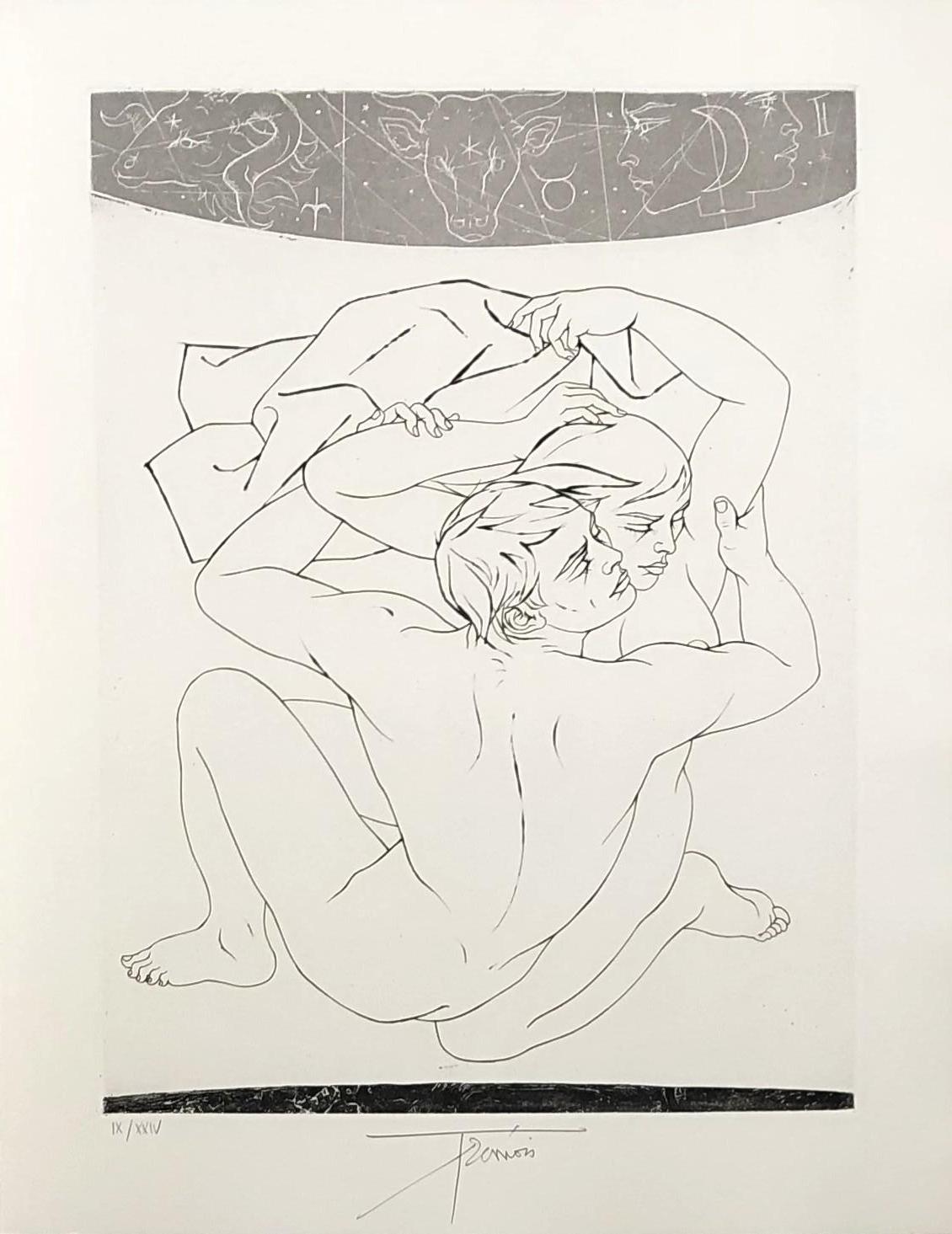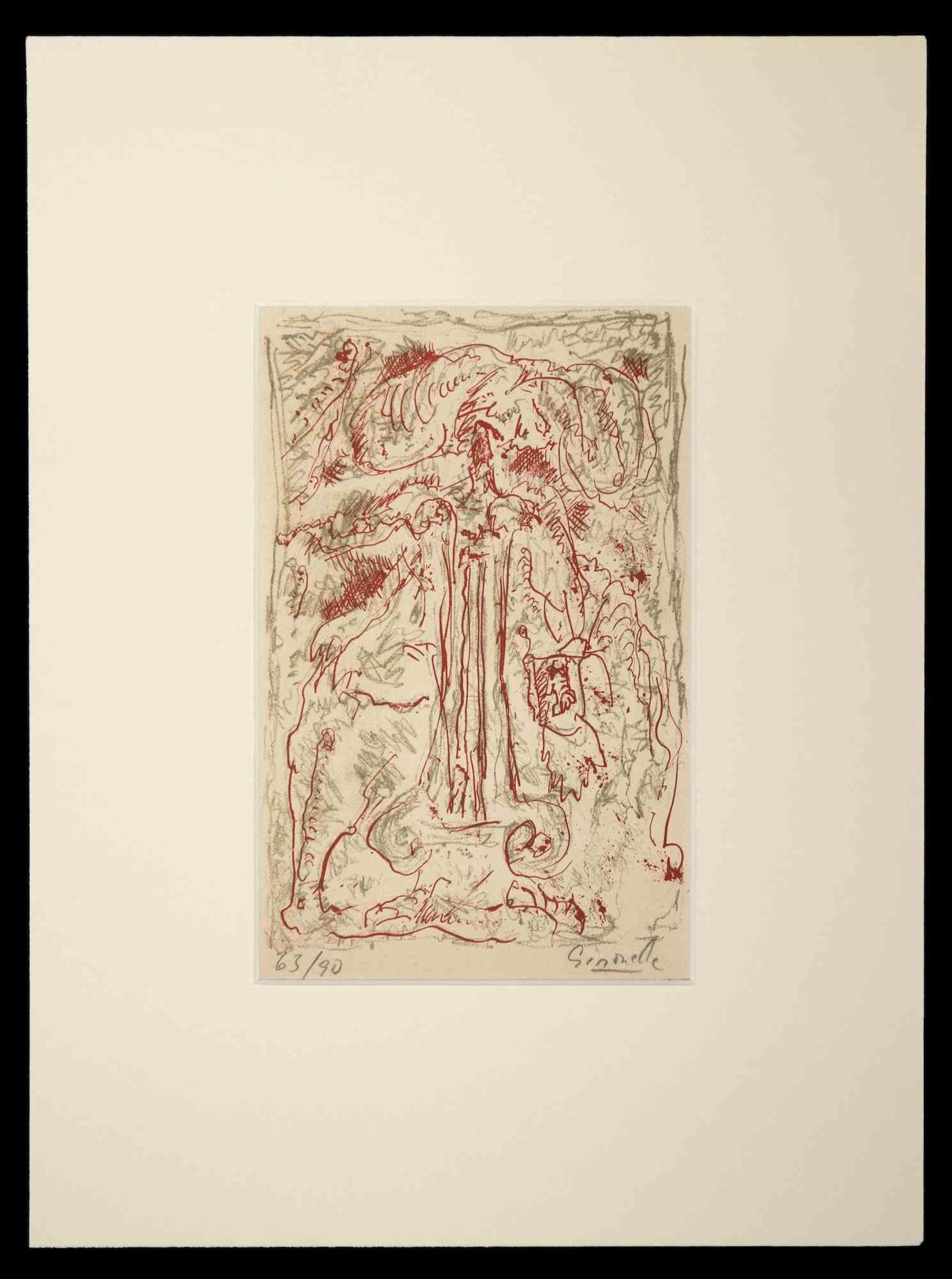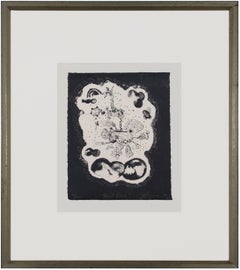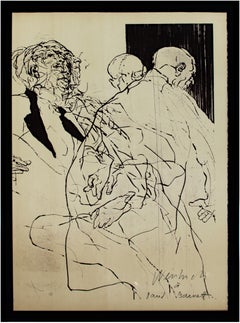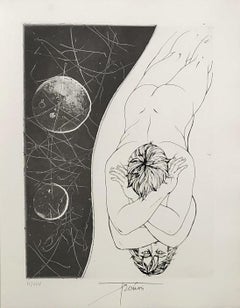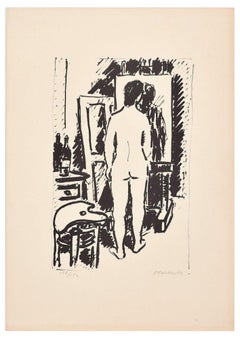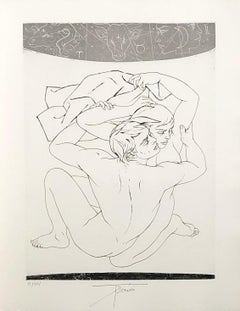Items Similar to "Back Cover of Derrière le Miroir #235" Original Lithograph
Want more images or videos?
Request additional images or videos from the seller
1 of 9
"Back Cover of Derrière le Miroir #235" Original Lithograph1979
1979
$2,000
£1,552.48
€1,761
CA$2,855.68
A$3,146.73
CHF 1,632.16
MX$37,426.13
NOK 20,646.32
SEK 19,341.22
DKK 13,152.04
About the Item
"Back Cover of Derrière le Miroir #235, M 946" is an original lithograph by Marc Chagall. This Chagall is a graphic piece, with black lines on a white paper. The main figure is a jester with curly hair and checkered pants and sleeves. In his right hand he holds a smiling mask, which compliments his own melancholy face. His awkward body placement, with his left leg seemingly coming from his left shoulder, shows he is a contortionist. Bellow the jester's feet is a goat, a common motif for Chagall, who has a bouquet of flowers above its head.
Image: 15 x 11 in
Framed: 23.13 x 19.13 in
Marc Chagall was born in Liozno, near Vitebsk, now in Belarus, the eldest of nine children in a close-knit Jewish family led by his father Khatskl (Zakhar) Shagal, a herring merchant, and his mother, Feige-Ite. This period of his life, described as happy though impoverished, appears in references throughout Chagall's work. The family home on Pokrovskaya Street is now the Marc Chagall Museum.
He began studying painting in 1906 with a local artist, Yehuda Pen. In 1907, he moved to St. Petersburg. There he joined the school of the Society of Art Supporters and studied under Nikolai Roerich. It was here that he was exposed to experimental theater and the work of such artists as Gauguin. From 1908-1910 Chagall studied under Leon Bakst at the Zvantseva School of Drawing and Painting.
This was a difficult period for Chagall; at the time, Jewish residents were only allowed to live in St. Petersburg with a permit, and the artist was jailed for a brief period for an infringement of this restriction. Despite this, Chagall remained in St. Petersburg until 1910, and regularly visited his home town where, in 1909, he met his future wife, Bella Rosenfeld.
After gaining a reputation as an artist, Chagall left St. Petersburg to settle in Paris to be near the burgeoning art community in the Montparnasse district, where he developed friendships with such avant-garde luminaries as Guillaume Apollinaire, Robert Delaunay, and Fernand Léger. In 1914, he returned to Vitebsk and, a year later, married his fiancée, Bella. While in Russia, World War I erupted and, in 1916, the Chagalls had their first child, a daughter named Ida.
Chagall became an active participant in the Russian Revolution of 1917. Although the Soviet Ministry of Culture made him a Commissar of Art for the Vitebsk region, where he founded Vitebsk Museum of Modern Art and an art school, he did not fare well politically under the Soviet system. "Chagall was considered a non-person by the Soviets because he was Jewish and a painter whose work did not celebrate the heroics of the Soviet people."[6] He and his wife moved back to Paris in 1922. During this period, Chagall wrote articles, poetry and his memoirs (in Yiddish,) which were published mainly in newspapers (and only posthumously in book-form). Chagall became a French citizen in 1937.
With the Nazi occupation of France during World War II and the deportation of Jews, the Chagalls fled Paris, seeking asylum at Villa Air-Bel in Marseille, where the American journalist Varian Fry assisted in their escape from France through Spain and Portugal. In 1941, the Chagalls settled in the United States where he lived until 1948 (his wife Bella died in 1944.) His wife Bella, who appears in many of his paintings, bore him one child, Ida and then died on September 2, 1944. Bella and Ida appeared in many of his early and most famous paintings. In 1945, he began a relationship with his housekeeper Virginia Haggard McNeil, with whom he had a son, David. In the 1950s, they moved to a villa in Provence. Virginia left him in 1952, and Chagall married Valentina Brodsky (whom he called "Vava").
Jewish influence:
Chagall had a complex relationship with Judaism. On the one hand, he credited his Russian Jewish cultural background as being crucial to his artistic imagination. But however ambivalent he was about his religion, he could not avoid drawing upon his Jewish past for artistic material. As an adult, he was not a practicing Jew, but through his paintings and stained glass, he continually tried to suggest a more "universal message," using both Jewish and Christian themes.
Later life:
He traveled several times to Greece and visited Israel in 1957. During this time, he rediscovered a free and vibrant use of color. His works of this period are dedicated to love and the joy of life, with curved, sinuous figures. He also began to work in sculpture, ceramics, and stained glass. In a recent book review of Chagall's biography, author Serena Davies writes, "By the time he died in France in 1985 - the last surviving master of European modernism, outliving Joan Miró by two years - he had experienced at first hand the high hopes and crushing disappointments of the Russian revolution, and had witnessed the end of the Pale, the near annihilation of European Jewry, and the obliteration of Vitebsk, his home town, where only 118 of a population of 240,000 survived the Second World War.
She later adds that the book "leaves us finally with an image of a man who came from nowhere to achieve world-wide acclaim. Yet his fractured relationship with his Jewish identity - he was physically divorced from his homeland, and he wasn't a practicing Jew - was unresolved and tragic. He would have died with no Jewish rites, had not a stranger stepped forward and said the kaddish, the Jewish prayer for the dead, over his coffin.
- Creation Year:1979
- Dimensions:Height: 23.13 in (58.76 cm)Width: 19.13 in (48.6 cm)
- Medium:
- Movement & Style:
- After:Marc Chagall (1887 - 1985, French)
- Period:
- Condition:
- Gallery Location:Milwaukee, WI
- Reference Number:Seller: 6290d1stDibs: LU60535176862
About the Seller
4.9
Gold Seller
Premium sellers maintaining a 4.3+ rating and 24-hour response times
Established in 1966
1stDibs seller since 2017
452 sales on 1stDibs
Typical response time: 1 hour
- ShippingRetrieving quote...Shipping from: Milwaukee, WI
- Return Policy
More From This Seller
View All'Mad Dash' original lithograph signed by Joseph Rozman
By Joseph Rozman
Located in Milwaukee, WI
'Mad Dash' is a print that exemplifies the work of Joseph Rozman during the 1970s, moving beyond the playful pictographs of the previous decade and morphing into an increasingly surr...
Category
1970s Surrealist Figurative Prints
Materials
Lithograph
"Hunting, " Original Etching and Aquatint signed by Molly McKee
By Molly McKee
Located in Milwaukee, WI
"Hunting" is an original etching and aquatint by Molly McKee. The artist signed the piece in the lower right, titled it lower center, and wrote the edition number (2/10) in the lower left. It depicts a few abstracted human figures in McKee's surreal and horror-inspired style.
11 3/4" x 9" art
24 7/8" x 17 1/2" frame
This surreal etching...
Category
1990s Surrealist Figurative Prints
Materials
Etching, Aquatint
Original Lithograph Baby Life Moments Family Female Figure Mother Black Signed
By Jean Charlot
Located in Milwaukee, WI
"First Steps" is an original lithograph created by Jean Charlot. This is a wonderful piece with hispanic styling, showing a mother teaching her child how to walk. The mother is shown standing behind the child holding it in a fabric sling. The child is shown in the foreground leaning into the fabric sling as it starts to take its first steps. The artist signed this work in the lower right.
Image Size: 13 7/8" x 9 3/4"
Paper Size: 17 1/2" x 12 5/8"
Frame Size: 23" x 19"
Artist Bio:
Louis Henri Jean Charlot was a French-born American painter and illustrator, active mainly in Mexico and the United States. Charlot’s mother’s family originated from Mexico City, and the artist was fascinated with Mexican manuscripts and pre-Columbian artifacts...
Category
1930s Other Art Style Figurative Prints
Materials
Paper, Ink, Lithograph
'Il bouge sans arrêt' original signed lithograph poster after drypoint, 1960s
By Claude Weisbuch
Located in Milwaukee, WI
This poster is a lithographic enlargement of the dry point print 'Il bouge sans arrêt' by the French artist Claude Weisbuch. The image is an early example of his explorations into th...
Category
1960s Contemporary Figurative Prints
Materials
Lithograph
"Le Prince Iris, " Surrealist Lithograph From "Je Reve" Portfolio
By André Masson
Located in Milwaukee, WI
"Le Prince Iris" is an original color lithograph by Andre Masson. The artist signed the piece lower right in pencil and wrote the edition number, H.C. XXV/X...
Category
1970s Surrealist Figurative Prints
Materials
Lithograph
"Hinting (With Chine Colle), " Etching & Aquatint signed by Molly McKee
By Molly McKee
Located in Milwaukee, WI
"Hinting" is an original etching and aquatint made with Chine Colle by Molly McKee. The artist signed the piece in the lower right, titled it lower center, and wrote the edition numb...
Category
1990s Surrealist Figurative Prints
Materials
Etching, Aquatint
You May Also Like
Narcisse - Original etching handsigned and numbered
By Pierre-Yves Trémois
Located in Paris, IDF
Pierre-Yves Tremois
Narcisse
Original etching, 1970
Handsigned by the artist
Numbered / XXIV copies (total edition of 90 + XXIV)
Size 57 x 45 cm (c. 22,4 x 17,7 in)
Very good condit...
Category
1970s Surrealist Figurative Prints
Materials
Etching
Nue dans le Miroir - Original Lithograph by R. Domenjoz - Mid 20th Century
By Raoul Domenjoz
Located in Roma, IT
Image dimensions: 20.5 x 13 cm.
Nue dans le Miroir is an original work realized by Raoul Domenjoz in the half of the XX Century.
Original lithograph. Numbered in pencil on the low...
Category
Mid-20th Century Figurative Prints
Materials
Lithograph
Lovers - Thétis and Pelée - Original etching handsigned and numbered
By Pierre-Yves Trémois
Located in Paris, IDF
Pierre-Yves Tremois
Thésis and Pelée
Original etching, 1970
Handsigned by the artist
Numbered / XXIV copies (total edition of 90 + XXIV)
Size 57 x 45 cm (c. 22,4 x 17,7 in)
Very goo...
Category
1970s Surrealist Figurative Prints
Materials
Etching
Surreal Composition - Original Lithograph - Mid-20th Century
Located in Roma, IT
Surreal Scene is an original lithograph realized by an anonymous Artist in the mid-20th Century.
Good Conditions.
Numbered. Edition, 63/90.
The artwork is depicted through soft st...
Category
Mid-20th Century Modern Figurative Prints
Materials
Lithograph
The Betrayers of Their Hosts - Original etching - 150ex
By Salvador Dalí
Located in Paris, IDF
Salvador Dali
The Betrayers of Their Hosts (1960)
Heliogravure reworked with drypoint
Printed signature in the plate
On BFK Rives Vellum paper
Size 32.8 x 26.4 cm (c. 13 x 10")
Ref...
Category
1960s Surrealist Figurative Prints
Materials
Etching
Composition Of Diodora - Original Lithograph by Bruno Capacci - 1950
Located in Roma, IT
Composition of Diodora is an original litography realized by Bruno Capacci in 1950.
The artwork is part of an edition in 500 pieces by "La nef d'argent" Paris.
In good condition, n...
Category
1950s Surrealist Figurative Prints
Materials
Lithograph
More Ways To Browse
Curly Hair Vintage
The Jester
Goat Feet
Christian Dior Black White Checker
Contortionist Vintage
Japanese Woodblock Tree
Jean Jacques Sempe
Jean Michel Folon On Sale
Jennifer Packer
Jim Dine 8 Hearts
Jim Dine Flowers
Jim Vest
Jockstrap Vintage
John Lawrence Doyle
John Lennon The Hug
John Stuart Curry
John Wesley Pop Art
Jorge Tacla
